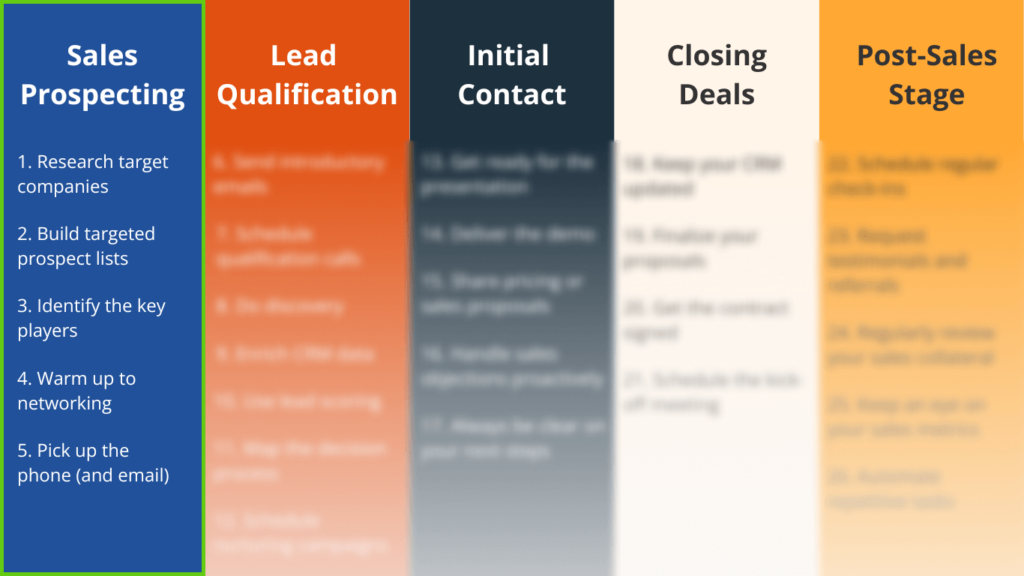

Are you overlooking any critical sales activities in your cycle?
If so, there’s room for improvement. You can scan this comprehensive list to identify if there are any actions that your sales process is lacking. They can also help you establish an effective sales process if you don’t have one already.
But before we dive deep into the list of different sales activities, let’s first agree on what they are and why they are so important.
What are sales activities?
These tasks, or sales activities, form the backbone of an effective sales process.
Sales activities are various actions and steps a salesperson takes throughout the sales cycle. These actions can range from initial research and prospecting to meetings and presentations.
What are sales activities important?
At first glance, sales activities are a given.
Every salesperson knows that they need to follow up regularly and do initial research before reaching out.
Nevertheless, if you’re doing the same tasks day in and day out, it’s easy to get bogged down and stop seeing the forest for the trees.
Here are the top 3 reasons why reviewing your sales activities is so important, especially when it comes to deal management.
1. Bring a structure to your sales process
By breaking down the sales process into specific tasks, you can ensure that no critical steps are overlooked. They can act as a roadmap that guides your team through each stage.
Besides, clearly defined sales activities will also help you prioritize your efforts and allocate time and resources effectively because you’ll know what is expected at every stage and what tasks are the most important.

2. Stay consistent in your sales efforts
Well-defined sales activities help you stay consistent in everything you do.
By establishing standardized processes, you can ensure that everyone on your team follows a specific set of steps, whose primary goal is to increase the likelihood of your sales success.
This consistency also makes it easier to find and later replicate successful strategies and improve your sales performance.
3. Identify areas for improvement
Since sales activities are specific actions, they are also measurable.
This allows you to track progress and analyze performance. By monitoring different sales activities, you can easily identify areas for improvement and increase your chances of closing more deals.
Who needs to know about sales activities?
There are several reasons why someone might search for “sales activities” on Google:
- Sales professionals may look for comprehensive lists of sales activities to ensure they are not overlooking any critical steps.
- Sales managers or leaders might search for sales activities to develop standardized processes, training programs, or performance metrics for their teams.
- Someone starting a sales career may research sales activities to better understand the day-to-day responsibilities and tasks.
- Business owners or entrepreneurs might seek information on sales activities to establish effective sales processes or optimize the existing ones in their companies.
- Sales trainers and coaches may search for sales activities to develop curriculum or training materials for their students or clients.
Top 26 sales activities in any business
Whatever your goal is, here’s a detailed list of sales activities:
- Research target companies
- Build targeted prospect lists
- Identify the key players
- Warm up to networking
- Pick up the phone (and email)
- Send introductory emails
- Schedule qualification calls
- Do in-depth discovery
- Update and enrich CRM data
- Use lead scoring
- Map the decision process
- Schedule nurturing campaigns
- Prepare presentation materials
- Deliver the demo
- Share pricing or sales proposals
- Handle sales objections proactively
- Always be clear on your next steps
- Keep your CRM updated
- Finalize your proposals
- Get the contract signed
- Schedule the kick-off meeting
- Schedule regular check-ins
- Request testimonials and referrals
- Regularly review your sales collateral
- Keep an eye on your sales metrics
- Automate repetitive tasks
To make it easier for you to scan through the list, we grouped them into different categories.
Llet’s look into each one of them in more detail.
Sales activities for prospecting
Prospecting is the lifeblood of any successful sales process.
Without a steady stream of fresh, qualified leads, even the smoothest closer will be stuck spinning their wheels. But filling up that pipeline? That’s an art form.
Let’s walk through some of the key sales activities that should be in every prospecting playbook.

1. Research target companies
Knowledge is power, so do your homework upfront. Understand your ideal customers—their industry, products/services, pain points, you name it. Leverage resources like company websites, social media, industry blogs, and publications to gather intel.
This research will allow you to personalize your outreach later and speak their language. When you can show a genuine understanding of their world, you’re already ahead of the game.
2. Build targeted prospect lists
Everyone is not your customer.
Once you’ve nailed down that ideal customer profile (ICP), it’s time to create your hit lists. These are hyper-targeted prospect lists of companies and contacts that fit your bull’s-eye.
Use tools like LinkedIn Sales Navigator or lead databases to find potential customers based on your criteria. But don’t sleep on this—continuously update and refine those lists to keep your eyes locked on the hottest prospects.
3. Identify the key players
Of course, you can’t just spray and pray. Within each target company, you need to map out the right player contacts—the key decision-makers and stakeholders involved in the buying process.
Leverage LinkedIn or company websites to understand roles, responsibilities, and reporting structures. This allows you to direct your outreach to the folks who actually have a say.
4. Warm up to networking
Don’t just chase cold leads—work your existing warm relationship channels. Attend local networking events, industry meetups, whatever your ICPs are gathering at. Establish expertise, build rapport, and get warm intros from existing customers.
People buy from people they know and trust, so this face-to-face networking is invaluable in prospecting.
5. Pick up the phone (and email)
Don’t be afraid to dial those cold calls, send cold emails, or semi-stalk your prospects on LinkedIn. It’s a hustle, but that’s the prospecting game.
Have a talk track and messaging ready that quickly captures attention and provides value. Be prepared to handle objections. Consistently committed prospecting is what separates the hunters from the hunted.
Sales activities for lead qualification
Once you have the leads in the pipeline, it’s time to separate the window shoppers from the real buyers.
Effective lead management is what takes you from a mere prospect to a legitimate sales opportunity.
There’s an art to properly qualifying and nurturing those hard-earned leads. Here are the key sales activities to master.

6. Send introductory emails
The first touch is crucial, so kick things off with a warm introductory email.
Don’t go for the hard sell. Simply introduce yourself, provide some value upfront, and set the stage for further conversation.
A thoughtful initial email can go a long way toward building rapport and credibility. Personalize each one and make a solid first impression.
7. Schedule qualification calls
Sending emails is not enough. You’ll need to progress things to an actual conversation.
Proactively schedule qualification calls to start qualifying your leads properly. Come prepared for every call with an outline of questions to ask.
But don’t turn it into an interrogation. Treat these calls as your chance to begin establishing needs and determining if it makes sense to continue with this lead.
8. Do in-depth discovery
For top-qualified leads, dive deeper into discovery mode.
Ask probing, open-ended questions to fully understand their current situation, objectives, budget, and decision criteria—all the crucial details. This will help you find an effective solution for them.
9. Update and enrich CRM data
After you add new leads to your Customer Relationship Management (CRM) system, take the time to gather and enrich all relevant contact details and organizational context. Make sure that your lead data is up-to-date and relevant.
Having these profiles updated in your CRM allows you to qualify better.
10. Use lead scoring
The main task of lead qualification is to get enough insights to score that lead against your qualification criteria.
Do they actually meet your target buyer profile in terms of budget, authority, need, and timeline?
If not, it may be time to disqualify and reallocate your efforts elsewhere. If there’s legit potential, progress them to the next stage.
11. Map the decision process
Don’t underestimate the power of organizational politics.
As you learn about the lead’s company dynamics, visually map out the decision process and all involved stakeholders. Identify influences, decision-makers, and potential roadblocks. This will help you strategically work different angles and navigate obstacles.
12. Schedule nurturing campaigns
Sales and marketing go hand in hand, especially when it comes to lead nurturing.
For those qualified-but-not-quite-ready leads, create nurturing campaigns. Get them engaged with your content and track their level of interest. When your leads are finally ready to hit “go,” you’ll be top-of-mind.
Sales activities for initial contact
Once your lead is qualified and engaged, it’s time to showcase your value. Initial sales meetings are where you lay the groundwork for signed deals.
Effectively running these early sales conversations is a skill. Here are the key sales activities to master.

13. Prepare presentation materials
First meetings are your chance to demonstrate true expertise about the prospect’s unique situation. Take the time to customize your presentation for each specific prospect based on the background you’ve already gathered.
Build tailored slides, demos, ROI calculations—whatever visuals and facts will resonate with them more. Generic pitches are a turn-off.
The more context you can weave in from the start, the more credibility you establish as a knowledgeable consultant rather than just another vendor.
14. Deliver the demo
After initial preparations, it’s time for your shining star—the product demo that directly shows how your solution can uniquely solve your prospect’s specific needs.
Asking thought-provoking questions during your demo is another good idea. This allows you to build rapport and credibility.
If your demo has data-driven ROI calculations and cost-benefit analyses, it’ll be easier for you to illustrate the full potential business impact.

15. Share pricing or sales proposals
During the initial contact stages, be prepared to discuss pricing and formalize a proposed solution. Provide quick turnaround on any pricing requests or indicate when they can expect a full proposal.
No one likes getting blindsided by unexpected costs. Be transparent about the budget but also firm about any non-negotiables. If your product doesn’t do X or Y and the prospect absolutely needs these features, you both might not be a good match. It’s okay to disqualify prospects even at the later stages of the sales cycle.
16. Handle sales objections proactively
In sales, objections are inevitable, so be prepared to handle them. Use these first meetings to identify potential areas of concern, acknowledge them directly, and resolve them whenever possible.
Have pre-written responses and rebuttals for common objections in your back pocket. The more seamless you can make this, the better.
17. Always be clear on your next steps
Don’t leave meetings open-ended. At the end of each meeting and call, ensure total clarity around the next steps and timeline. Whether it’s proposals, demos, meetings, or decision dates—get clear on commitment.
Stagnant deals rarely stay unstuck for long. That’s why it’s important to schedule immediate follow-ups. Don’t risk losing the prospect’s attention—strike while the iron is hot.
Sales activities for closing deals
Now it’s time to get signatures on the dotted line. This delicate final stretch is where sales deals can just as easily accelerate across the finish line or sputter out entirely.
Follow these key sales activities to ensure you cross the finish line.

18. Keep your CRM updated
With all the back-and-forth happening in sales, it’s mission-critical to maintain a central system of records throughout the whole process. It’s not just another business app. Your CRM should be your single source of truth.
Diligently log every detail, action item, and communication in your CRM: updated deal details, proposals sent, call notes, stakeholder info, and so on. Even if sales inevitably get chaotic, your CRM is there to help you, it’s your command central.
19. Finalize your proposals
Once you send the proposal to your prospect, there’s no guarantee that they’ll sign the contract immediately. There will probably be some negotiations and back-and-forth messages involved.
During final negotiations, make sure that your proposal satisfies all parties. Spell out exact pricing, deliverable timelines, payment schedules—you name it. Sweat the small (but crucial) stuff now to avoid friction or confusion later.
20. Get the contract signed
Once all legal steps are complete, it’s time to put pen to paper (or fingers to trackpad?) and get the well-deserved signatures. If needed, set reminders to follow up persistently until you get that final confirmation.
21. Schedule the kick-off meeting
Always take time to map out a smooth transition into delivery and implementation. As soon as the deal is closed, immediately schedule an official kickoff meeting.
Get implementation teams, technical resources, customer stakeholders, and anyone else who needs a seat at the table booked on calendars. Customer retention partly depends on how good your kickoff coordination is.
Sales activities for post-sales stages
Congratulations, the deal is sealed! But it doesn’t mean your relationship with the client has ended.
Now your company needs to work on building a long-term relationship with the new customer (and getting repeat business). In big companies, these activities are often part of the account management team.

22. Schedule regular check-ins
Check-in calls are touchpoints that allow you to keep your customers satisfied and identify potential problems before they arise. Never let your customers feel like they’ve been forgotten.
These calls are also a perfect opportunity for gathering feedback. What good is a shiny new solution if it’s not delivering the results?

23. Request testimonials and referrals
Speaking of results, there’s no better sales asset than a customer advocate. Find your happiest accounts and turn them into case studies and testimonials that market your product. Case studies and testimonials allow you to vividly illustrate your value. Social proof is invaluable for growing sales.
Also, don’t be afraid to ask for referrals. They are the primary source of revenue for the majority of small businesses.
24. Regularly review your sales collateral
Content is king in this modern selling world. But does your library of pitch decks, case studies, and ROI calculators still have that fresh sizzle? Or is it getting a bit stale and commoditized?
Regularly audit and refresh your sales materials with the latest customer success stories and industry developments. Partner up with your marketing team to breathe new life into your sales pitch.
25. Keep an eye on your sales metrics
With all your sales activities neatly recorded in your CRM, you have a goldmine of performance data at your fingertips.
Leverage this data to look into your conversion rates, sales cycle bottlenecks, and lost deals reasons. Identify those leaks in the pipeline and double down on your most vulnerable areas.
26. Automate repetitive tasks
Speaking of vulnerabilities, are there any parts of your quoting, proposal, or contract processes that consistently trip you up or slow you down?
Find those areas of friction or inefficiency to automate them. For example, introduce team-wide email templates that everyone can use when communicating with new prospects or sharing your latest pricing.
Every hour saved is an extra hour spent on building relationships.
Mastering sales activities
Sales aren’t just about numbers and transactions. They are about specific actions that salespeople do every day. Whether it’s creating connections or solving problems, sales activities are an intrinsic part of your sales process.
To increase sales, you need to have a holistic overview of your funnel—this is what sales activities help you achieve. By focusing on these actionable strategies, you’re not just selling, you’re building lasting relationships.













